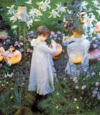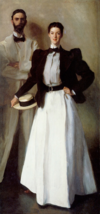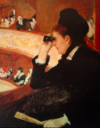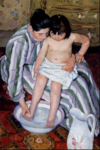American Expats, Foreign Painting, Impressionism Flashcards
James McNeil Whistler
Born in CT, raised overseas, does not consider himself American, most of career spent in England, Influenced many American artists
1856 works in Charles Hayden studio
Etching important to his career - looseness of lines, improvisational, quick
interested in design, aesthetics, composition, color, form
not concerned about subject matter and tension
art for art’s sake - radical
tonalism - narrow range of color, subtle gradations
precursor to American modernism
Whistler’s Etching
extremely important to his career
loose line, improvisational, quick, spontaneous
differs from engraving
cooper medium, soft, limits number of good impressions

James Abbott McNeil Whistler
Title page from “The French Set”
1859
engraving process with wax on copper plate
acid bath
varnish to block out areas
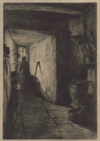
James Abbot McNeil Whistler
The Kitchen
Clancy favorite - remarkable shadow

James Abbott McNeill Whistler
In Full Sun
1858
wide range of tonality
works directly from nature

James Abbott McNeil Whistler
Mother Gerard
1858
woman from bourgeois background fallen on hard times
reduced to selling flowers at popular dance hall
final gives sense of how much he can re-work images
deeper tonal range

James Abbott McNeil Whistler
At the Piano
1858-59
first major oil painting, rejected by Paris Salon, 1860 accepted by London Academy
somber tonality
failure in Paris and positive reception in London encouraged his move

James Abbott McNeil Whistler
1859
“The Thames Set” Old Westminister Bridge
successful series established reputation
shows freedom of etching compared to engraving

James Abbott McNeil Whistler
Wapping
1860
Clancy favorit
model Joanna Heffernan who eventually became his mistress
color, atomospheric, cropped view - importance of Japanese prints
moving towards solidity and firmness
shown in NY in 1866, returned to Paris as part of Exposition 1867

James Abbott McNeil Whistler
Symphony in White No. 1, the White Girl
1862
mistress Joanna model, first of 4 symphonies in White
rejected initially, aesthetic exploration of white on white - about paint not the figure, gradations of white and color
influence of japanese prints, pressed against picture plan
doesnt function like a portrait, unnatural quality to white

James Abbott McNeil Whistler
Purple and Rose: The Lange Leizen of the Six Marks
1864
not about fidelity to culture, not really Asian
1863 onward starts introducing orientalism from his own collection into works
Eastern signs and signals into very Western image
change in structure due to wood block prints, cropping, flat blocks of color

James Abbott McNeil Whistler
Arrangement in Grey and Black, The Artist’s Mother
1871
influence of Japanese prints, patterned cloth framing
lacks a model, uses his mother, not about identity
study of color, tone, patterns, space conceived as artistic arrangements, flat areas of grey, balck, echoing picture frame on wall, voluminous black dress, study of black, portrait stripped to essentials, basic geometry
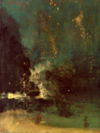
James Abbott McNeil Whistler
Nocturne in Black and Gold: The Falling Rocket
1875
Nocturne = dreamy, instrumental music
abstract, night scene, pensive, tonal harmony, mood generated by greys, blacks, gold
reduced to splashes of color, aesthetic investigation, mood generated

John Singer Sargent
Oyster Gatherers of Cancale
1878
combined formal painting arrangement with naturalism
abitious, plein air painting, inspired by Barbizon and impressionists
John Singer Sargent
American parents, born in Florence, cosmopolitan, 4 languages, high society
did not visit US until 21
leading portrait painter of high society
thicker brushstrokes, tonal harmony
studio of Carolus Duran, Ecole des Beaux-Arts
inspired by Barbizon, Impressionism
progressive teacher encouraged working directly on canvas
indebted to old masters - Frans Hals, Velazquez

John Singer Sargent
Luxembourg Gardens at Twilight
1879
modernist vein, more tonal, thick swaths of color
promenade, purpose to be seen, fashionable place to spend time
city as spectacle

John Singer Sargent
Venetian Glass Workers
1880-82
very Velazquez, brushy
conveyance of glass capturing light, recession into space
glowing rods of glass - tonal range




